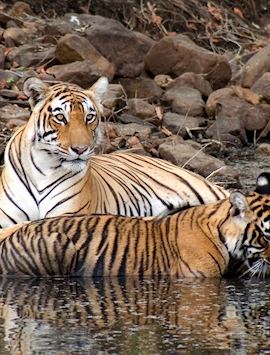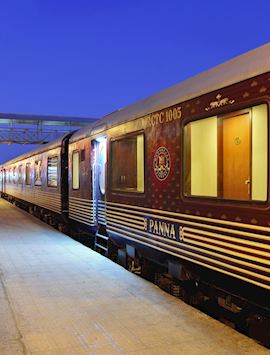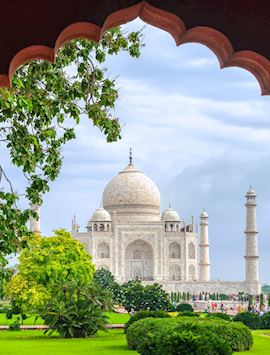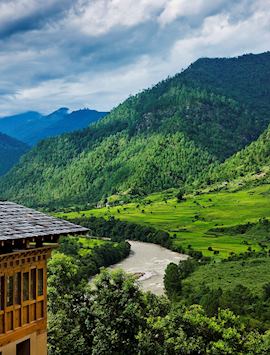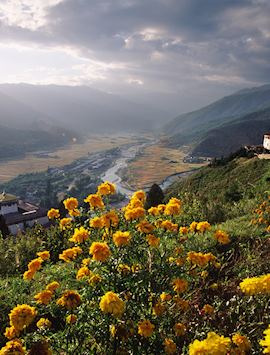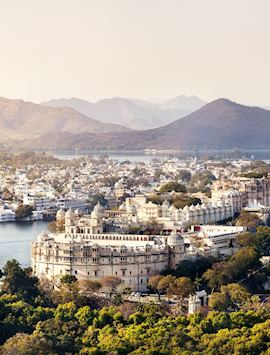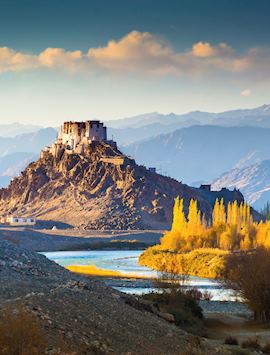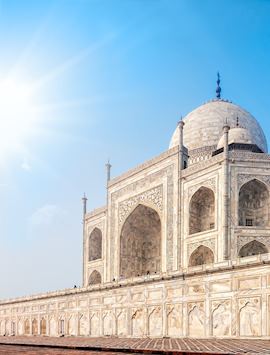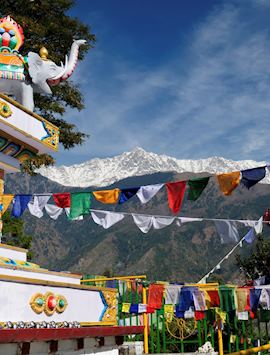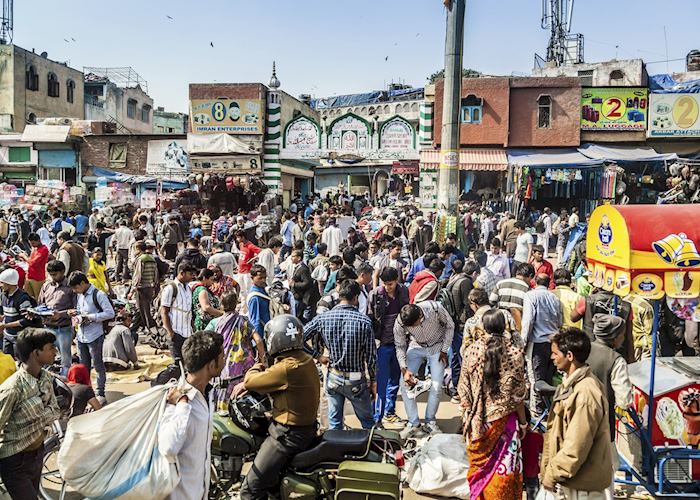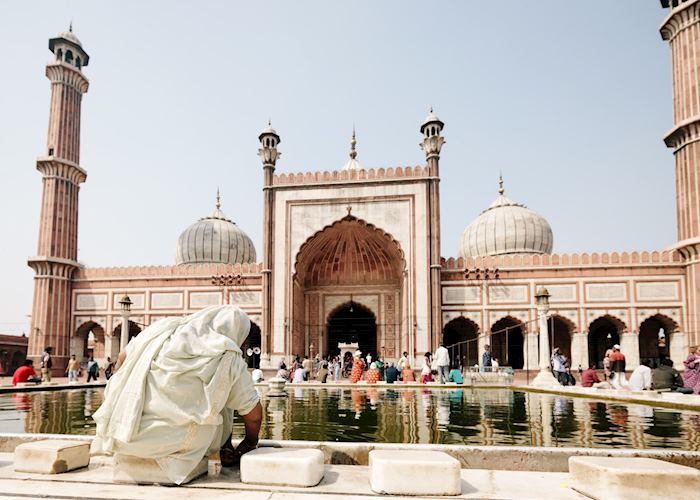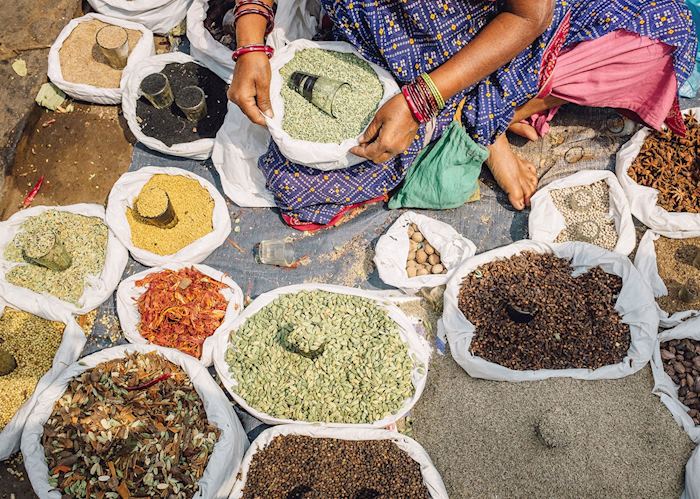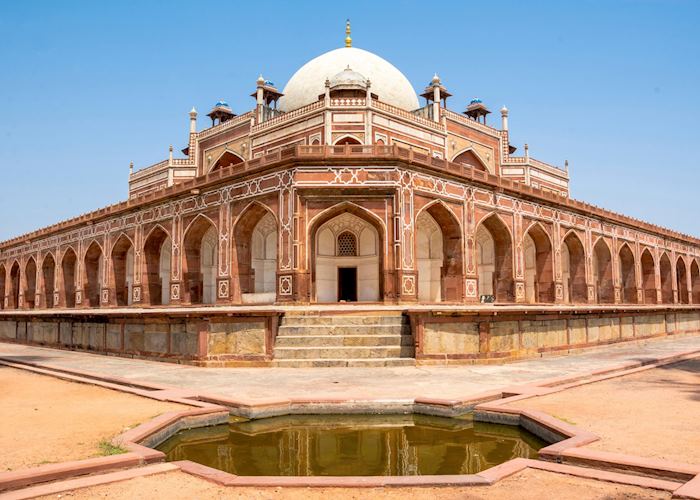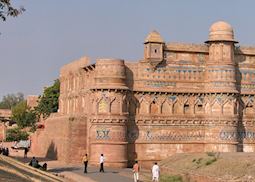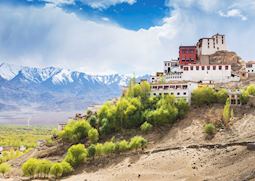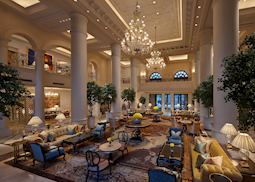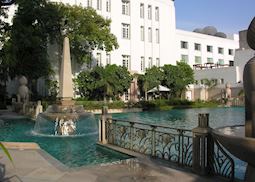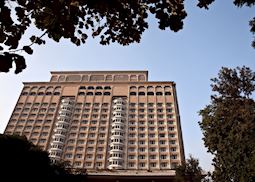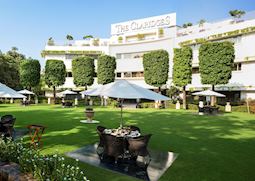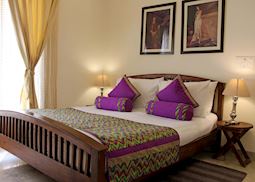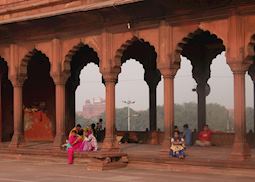Jump to:
Sari-clad women, vibrant flower markets, imposing architecture and treasured temples: all the nuances of India are on show in Delhi. Often seen as merely a transit hub to explore the wider area, it's worth investing some time here. Established in 1,000 BC, Delhi has a rich history that's tangible through its line-up of sites. Explore the legacy of the Mughal Empire at the Red Fort and the Jama Masjid Mosque of Old Delhi before getting a feel for colonial India with the vast boulevards of New Delhi. The city's architecture is some of the finest in North India, but Delhi's warm inhabitants are keen to show you their city in other ways, and we can arrange activities such as taking a cooking lesson at a family-run hotel or visiting a local community project.
India specialist GrahamThe first time I arrived in Delhi, I was struck by the chaos of the markets, the grandeur of the architecture and the noise of the traffic. An assault to every sense, it's a fascinating city to explore.
Things to see and do in Delhi
High tea at the Imperial Hotel
Built in the 1930s to reflect the luxuries of the colonial era, the Imperial Hotel is best appreciated by attending afternoon tea there. Served on silverware imported from London, you're presented with a platter of delicate pastries, tarts and scones, with poured tea from heritage china.
The hotel is proud to own one of the largest colonial and post-colonial Indian art collections in Delhi. After enjoying tea, you can take a tour of the display with a hotel guide.
New Delhi
Imperial architecture rubs up against Mughal ruins in New Delhi. The city's heritage is best appreciated in this district, and the Rajpath (Hindi for "King's path") is the ceremonial route, surrounded by well-kept lawns, that cuts through its heart. Stroll along the path past sellers of everything from postcards to dried chillies, until you reach India Gate. A memorial to soldiers who lost their lives during World War I, visit in the evening to see it gently illuminated.
The diplomatic enclaves that surround the Rajpath were designed primarily by British architect Sir Edwin Lutyens. Only a privileged few are allowed past the gated gardens into these buildings, but the exteriors show a fascinating mix of classic British and Indian features. Meander a little further to find Humayun's Tomb, a 16th-century mausoleum often considered a precursor to the Taj Mahal.
Take a guided walk through Delhi's Old Town
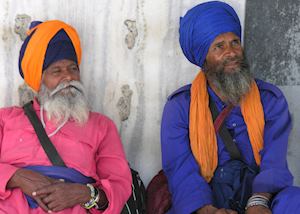 With settlements dating back to 700 AD, Delhi's Old Town was actually built north of the original community. Built as a walled city by Shah Jahan in 1639, it became the capital of the Mughal Empire. With narrow, twisting streets, Delhi's old town is best explored on foot. Starting off in the markets, you can explore the bazaar and ordinary items being sold here, from the vibrant wedding sector full of garlands and fabrics to an area completely devoted to cutlery.
With settlements dating back to 700 AD, Delhi's Old Town was actually built north of the original community. Built as a walled city by Shah Jahan in 1639, it became the capital of the Mughal Empire. With narrow, twisting streets, Delhi's old town is best explored on foot. Starting off in the markets, you can explore the bazaar and ordinary items being sold here, from the vibrant wedding sector full of garlands and fabrics to an area completely devoted to cutlery.
Eventually, you burst out of the other side to the expansive courtyard in front of Delhi's Red Fort. Designed by the creator of the Taj Mahal, its red sandstone walls once held back vast armies and are a reminder of the might of the Mughal Empire.
Nearby is the Jama Masjid, one of India's largest mosques. Visitors are welcome, and you can hire robes to wear inside at the entrance. A social hub of the local community, the men can be seen crouched in deep discussion while children play in the central courtyard.
Relax in the Lodhi Gardens
A peaceful escape from the hubbub of Delhi's streets, everyone from business-brokering elites to gossiping teenagers frequents the Lodhi Gardens in the early evening. Orderly arrangements of palm-lined paths lead past rare plants, which have been helpfully labelled for visitors.
The park was originally a burial site for the Lodi dynasty, ruling from 1451 to 1525 — collapsing as the first Mughal emperor, Babur, captured Delhi in 1526. Their tombs are scattered between the neatly arranged flowerbeds and lawns. The tomb of Muhammad Shah, with its meticulous stone carvings and a multi-domed roof, is a particular highlight.
Visit the Nizamuddin Basti Hope Project
The Sufi teacher Pir Vilayat Inayat Khan was moved to set up the Hope Project by the poverty of the families living in the Nizamuddin Basti suburb of central Delhi. Started in 1908, the charity aims to help vulnerable inhabitants unlock their potential and, to do this, it trains them to run a number of programmes, including a school, health centre and women's enterprise unit.
Guided by a member of the community, you can step into the backstreets of Delhi to see the project's work. Squeezing past local markets and tea stalls, you'll see residential Delhi from the inconspicuous local mosques and tiny meeting halls. Everyone is keen to show you their role in the project, from young nurses being trained in the health centre to women gaining independence by learning local crafts.
Sample Delhi's street food
Delhi offers some of the finest restaurants in Asia, but local people still prefer to patronise Delhi's dazzling variety of street food. In the evening, the city's sprawling markets of Chandni Chowk and Chawri Bazaar fill with the smell of frying pastries and grilled meats. Battered metal hatches open up to reveal skilled preparations that have been passed through generations, rolling the perfect roti or folding the neatest samosa.
On a guided tour you're talked through the huge variety of food on offer, sampling your way through specialities such as stuffed paranthas (Indian flatbread), aloo chaat (fried potatoes) and butter chicken. Finish with phiri, a creamy milk-and-rice-based dessert served in a clay pot, or a fruit flavoured kulfi, Indian ice cream.
Learn to cook Rajasthani specialities
You can start to decipher the art of Rajasthani cooking at Shanti Home, a family-run boutique hotel that arranges afternoon cooking lessons with their experienced chefs. Before getting near the kitchen, you'll accompany your chef to one of Delhi's food markets, which overflow with countless types of fruits and vegetables, and towering piles of spices.
You'll learn subtleties such as the 18 different types of chilli grown in India and how different ghees (clarified butter used for cooking instead of oil) affects the finished dishes. You'll then help the chefs prepare a traditional meal before enjoying it in the hotel's rooftop restaurant with the streets of Delhi ever noisy below.
Best time to visit Delhi
Delhi is best visited in October to March when the monsoon rains have finished and temperatures average a comfortable 30°C (86°F). December and January can be surprisingly cool though — but a little quieter — with evening temperatures dropping to 10°C (50°F). By April they climb up to 40°C and, coupled with high humidity, this makes exploring uncomfortable.
Festivals, events and seasonal reasons to visit
The Indian calendar is saturated with festivals and important dates. The more well-known festivals can attract large crowds and make travel difficult. One of Delhi's most satisfying experiences is the thrill of accidentally happening upon a local puja (prayer ritual), or small family event.
- On 26th January, Delhi comes to a complete standstill as Independence Day is celebrated. A parade runs through the city with the arch of India Gate in the background.
- Usually celebrated in late October or early November, Diwali, the ancient Hindu festival of light, is a blaze of candles, rich decorations and fireworks.
- The spring festival of Holi celebrates traditional Hindu stories of good overcoming evil. Families gather in the evening, lighting bonfires and roasting corn. The next day is marked by large parties in the street, where festival goers smear vivid powders and paints over each other. In Delhi it can be overwhelming to see and is often best viewed from a rooftop café above the streets.
who's been there
-
01993 838 92501993 838 345
- Make an enquiry
Suggested itineraries featuring Delhi
Our itineraries will give you suggestions for what is possible when you travel in Delhi, and they showcase routes we know work particularly well. Treat them as inspiration, because your trip will be created uniquely by one of our specialists.
Places near Delhi
- Bharatpur and Keoladeo Ghana National Park 100 miles away
- Haridwar 107 miles away
- Fatehpur Sikri 110 miles away
- Agra 112 miles away
- Corbett Tiger Reserve 119 miles away
- Rishikesh 122 miles away
- Samode 132 miles away
- Mussoorie 137 miles away
- Nainital 145 miles away
- Jaipur 147 miles away
- Chambal Sanctuary 153 miles away
- Almora 162 miles away
- Ramathra 166 miles away
- Shimla 171 miles away
- Gwalior 178 miles away
- Ranthambhore National Park 188 miles away
- Pushkar 221 miles away
- Pragpur 229 miles away
- Nagaur 236 miles away
- Barli 242 miles away
- Bikaner 242 miles away
- Bundi 242 miles away
- Orchha 244 miles away
- Amritsar 251 miles away
- Shahpura 252 miles away
- Dharamshala & McLeod Ganj 254 miles away
- Nimaj 263 miles away
- Chhatra Sagar 264 miles away
- Bhainsrorgarh 274 miles away
- Deogarh 297 miles away
Photos of Delhi
Our expert guides to exploring Delhi
Written by our specialists from their own experiences of visiting Delhi, these guides will help you make the most of your time there. We share both our practical recommendations and the best ways to appreciate Delhi at its best.
-
Touring India’s Golden Triangle ![Hawa Mahal in Jaipur]()
Touring India’s Golden Triangle
Touring India’s Golden Triangle
The Taj Mahal is just one of many impressive sights on a tour of India’s Golden Triangle. For first-time visitors, the region offers a tempting taste of the vast range of cultures, historical sites, architecture, religion, food and landscapes that India boasts.
Read this guide -
The best of Rajasthan: why stay in an Indian fort ![Gwalior Fort]()
The best of Rajasthan: why stay in an Indian fort
The best of Rajasthan: why stay in an Indian fort
Rajasthan is often defined by its range of towering stone fortresses. Here, India specialist Lydia leads you on a tour of the smaller forts that you can spend a night in, and picks out four of the best.
Read this guide -
Summer in India: Ladakh ![Thiksey Monastery in Leh, Ladakh]()
Summer in India: Ladakh
Summer in India: Ladakh
Considering India between June and September? India specialist James explains that, while much of the country is too hot or wet to visit, it’s the ideal time of year to explore mountainous Ladakh, a region of high-altitude deserts, Buddhist monasteries and sheer-sided mountains.
Read this guide
Accommodation choices for Delhi
We've selected a range of accommodation options for when you visit Delhi. Our choices usually come recommended for their character, facilities and service or location. Our specialists always aim to suggest properties that match your preferences.
-
![The Leela Palace New Delhi, Delhi]()
The Leela Palace Delhi
Delhi -
![Deluxe room, The Oberoi New Delhi]()
The Oberoi New Delhi
Delhi -
![Imperial Hotel, Delhi]()
The Imperial
Delhi -
![Taj Mahal Hotel, Delhi]()
Taj Mahal Hotel
Delhi -
![Swimming pool, Pullman, Delhi Aerocity]()
Pullman Aerocity
Delhi -
![Pool, Maidens Hotel, Delhi]()
Maidens Hotel
Delhi -
![Claridges, Delhi]()
The Claridges
Delhi -
![The Maharajas' Express Train]()
Maharajas' Express
Delhi -
![Bedroom, Haveli Dharampura]()
Haveli Dharampura
Delhi -
![Colonel's Retreat]()
Colonel's Retreat
Delhi
Ideas for experiencing Delhi
Our specialists seek out authentic ways to get to know the places that could feature in your trip. These activities reflect some of the experiences they've most enjoyed while visiting Delhi, and which use the best local guides.
-
Old Delhi city tour ![Jama Masjid, Delhi]()
Old Delhi city tour
Old Delhi city tour
Your guide will take you on a cycle rickshaw through the Chandni Chowk Bazaar area. This allows you to visit the narrow winding alleys lined with shops selling all manner of items.
View details -
Night walk of Chandni Chowk, old Delhi ![Sikh Gentlemen, Delhi]()
Night walk of Chandni Chowk, old Delhi
Night walk of Chandni Chowk, old Delhi
This night walk around Chandni Chowk in Old Delhi shows you the capital when it is most alive — in the evening.
View details



